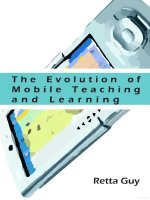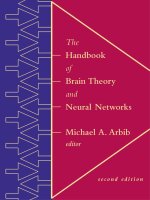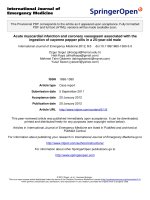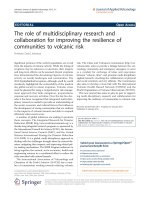Using supplementary reading materials with the course book business basics to improve the efficiency of reading teaching and learning for second - year students at Bac Ha College of Technology
Bạn đang xem bản rút gọn của tài liệu. Xem và tải ngay bản đầy đủ của tài liệu tại đây (179.17 KB, 5 trang )
Using supplementary reading materials with the
course book business basics to improve the efficiency
of reading teaching and learning for second - year
students at Bac Ha College of Technology
Đào Thị Hoa
Trường Đại học Ngoại ngữ
Luận văn Thạc sĩ ngành: Methodology; Mã số: 60 14 10
Người hướng dẫn: Phan Thị Vân Quyên
Năm bảo vệ: 2010
Abstract. It is undeniable that reading plays an important role in the process of teaching and
learning a language. The improvement of reading skills is one of the most effective ways to enhance
language proficiency of the learners. It is clearly realized that the textbook is a key element of English
language teaching. However, it is widely thought that in the process of developing reading skills, an
indispensable factor which contributes to the success of the learners is reading materials. This research
was carried out to find out the teachers‟ and the second year students‟ evaluations of the current
textbook and their expectations of supplementary reading materials to improve the teaching and
learning reading skills for both teachers and students at Bac Ha College of Technology. The findings
from two sets of questionnaires indicate that in spite of strong points the present textbook Business
Basics has, it still fails to satisfy both teachers‟ and students‟ needs and interests. Therefore, the
researcher suggests the using of supplementary materials to improve the effectiveness of teaching
reading as well as reinforce learning reading of the second year students.
Keywords. Kỹ năng đọc; Tiếng Anh; Phương pháp dạy hoc
Content
Table of contents
Acknowledgements………………………………………………………………………… i
Abstract……………………………………………………………………………………. ii
List of tables and charts………………………………………………………………… iii
Table of contents………………………………………………………………………… iv
Part a: Introduction
1. Rationale………………………………………………………………………………… 1
2. Aims of the study……………………………………………………………………… 2
3. Significance of the study……………………………………………………………… 2
4. Research questions……………………………………………………………………… 2
5. Methodology……………………………………………………………………………. 3
6. Design of the study……………………………………………………………………… 3
Part B: development
Chapter 1: Literature review
1.1. An overview of reading……………………………………………………………… 4
1.1.1. Definitions of reading comprehension…………………………………………. 4
1.1.2. Models of reading .…………………………………………………………… 4
1.1.3. Reading skills and types of reading skills……………………………………… 5
1.1.3.1. Definition of reading skills……………………………………………… 5
1.1.3.2. Types of reading skills………………………………………………… 5
1.2. Materials development in language teaching…………………………………………. 7
1.2.1. Definition of language teaching materials……………………………………… 7
1.2.2. Processes in materials development……………………………………………. 7
1.2.2.1. Materials evaluation……………………………………………………… 8
1.2.2.2. Types of materials evaluation…………………………………………… 8
1.2.2.3. Criteria for materials evaluation………………………………………… 9
1.2.3. Supplementary materials in teaching reading skills………………………… 10
1.2.3.1. Definition of supplementary materials………………………………… 10
1.2.3.2. Criteria for selecting supplementary materials………………………… 10
1.2.3.3. How to use supplementary materials……………………………………. 11
Summary
Chapter 2: Methodology
2.1. Background to the study…………………………………………………………… 14
2.1.1. The setting……………………………………………………………………. 14
2.1.2. The textbook Business Basics……………………………………………… 14
2.1.3. Participants…………………………………………………………………… 15
2.1.3.1. The teachers…………………………………………………………… 15
2.1.3.2. The students…………………………………………………………… 16
2.2. Instrument for data collection……………………………………………………… 16
2.2.1. The questionnaire for teachers……………………………………………… 16
2.2.2. The questionnaire for students……………………………………………… 17
2.3. Data collection procedure……………………………………………………………. 17
Chapter 3: Data analysis, findings and discussion
3.1. Data analysis…………………………………………………………………………. 18
3.2. Findings and discussion……………………………………………………………… 27
3.2.1. The teachers‟ and the students‟ evaluations of the current textbook
Business Basics……………………………………………………………………… 27
3.2.2. The teachers‟ and the students‟ expectations of supplementary
reading materials…………………………………………………………………… 28
Chapter 4: Recommendations
4.1. Suggestions for selecting supplementary materials………………………………… 29
4.2. Designing tasks and activities for reading passages…………………………………. 30
4.3. Sample supplementary readings……… ……………………………………………. 30
Part C: conclusion
1. Conclusion of the study……………………………………………………………… 37
2. Limitations of the study and suggestions for further study……………………………. 37
References 39
Appendices
Appendix 1: Questionnaire for teachers
Appendix 2: Questionnaire for students
INTRODUCTION
1. Rationale
Nowadays, in the time of globalization, English plays an essential role in the increasing
development of science, technology, politics, economics, tourism, culture and so on. English language
is not only considered as a means of communication but also a key to access the important
achievements of science and technology. Therefore, learners of English should acquire this language
and teaching and learning English become popular in our country.
Among four language skills, reading is very important in learning a foreign language as reading
helps students to widen their knowledge and understand different academic materials written in
English. Carrel (1981: 1) also emphasizes “for many students, reading is by far the most important of
the four skills in a second language, particularly in English as a second or foreign language”. It is
necessary for the second year students at Bac Ha College of Technology to develop reading ability
effectively because reading provides a lot of useful information as well as enrich their language
vocabulary and structures. Reading will be an effective way to help students enhance their English
proficiency especially their reading skills. Nevertheless, despite the teachers‟ and students‟ efforts, the
students at Bac Ha College of Technology have a poor reading result that makes them uninterested in
learning English in general and in learning reading skill in particular.
The students‟ English proficiency at Bac Ha College of Technology is not the same. It is due to
the fact that they come from different places. Most of them come from the countryside so they can not
have preferable English learning condition. The others come from towns and cities where they have
more convenient condition of learning English. This results in low English proficiency of the students
because of their limited vocabulary and grammar. In addition, they do not have appropriate reading
strategies and background knowledge. Therefore, students face a lot of difficulties in reading and
understanding the long texts especially the texts relating to economic fields which they are studying. As
a result, they find it hard to be successful in their reading and they are not interested in reading.
With the purpose of improving their English knowledge, it is very important for the teachers to
provide them as many opportunities to read as possible. Nuttall in the book “Teaching reading skills in
a foreign language” (1982) states that “reading as a purposeful activity, we can make teaching more
purposeful and classes livelier, even in the difficult circumstances”.
All the above reasons have inspired me to carry out the study on “Using Supplementary Reading
Materials with the Course book Business Basics to Improve the Efficiency of Reading Teaching and
Learning for Second-year Students at Bac Ha College of Technology”, with a hope to improve the
teaching and learning English as well as the teaching and learning reading comprehension.
2. Aims of the study
The purpose of the study is to find ways of developing the effective reading materials so as to improve
the teaching reading skill of the teachers as well as to enhance the students‟ learning reading. The
specific aims of this research are as follows:
- To find out some different evaluations made by teachers and students towards the textbook Business
Basics, which is currently used by the second year students at Bac Ha College of Technology.
- To examine the teachers‟ and the students‟ expectations of supplementary reading materials.
- To give recommendations for selecting supplementary materials to improve teaching reading of the
teachers as well as learning reading of the students.
3. Significance of the study
This study is of great importance to the author herself as well as to all teachers of English. It helps to
reinforce students‟ English proficiency and suggests ways to improve the teaching of English in general
and reading in particular at Bac Ha College of Technology and most schools and universities that share
the same mandate.
4. Research questions
On the basis of the problems, the following research questions were formulated to conduct this
study.
1. What are the teachers‟ and the students‟ evaluations of the textbook Business Basics?
2. What are the teachers‟ and the students‟ expectations of supplementary reading materials?
5. Methodology
The methods used in the study is quantitative and qualitative. A questionnaire is used as a main
instrument for data collection. Two sets of questionnaires were designed and delivered to the teachers
and the second-year students at Bac Ha College of Technology in order to find out answers to the
research questions. The data were collected, synthesized and analyzed from the survey questionnaires
for both teachers and students on their evaluations of the current textbook and their expectations of
supplementary reading materials.
6. Design of the study
This study is divided into three parts.
Part A is the introduction in which the rationale, aims of the study, significance, research questions,
methodology and design of the study are stated.
Part B is the development, the main part of the study. In this part, there are four chapters.
Chapter 1 reviews the literature concerning an overview of reading, reading comprehension with
models of reading process, the theory of materials development and supplementary materials in
teaching reading skills.
Chapter 2 presents methodology of the study consisting of the background to the study. It covers the
setting, the textbook Business Basics, the participants, the instrument as well as data collection
procedure.
Chapter 3 goes into details of the data analysis, findings and discussion.
Chapter 4 briefly deals with recommendations of the study.
Part C comes up with the summary of the study in which limitations of the study and suggestions for
further research are also presented.
References
Alderson, J.C. (2000). Assessing Reading. Cambridge: Cambridge University Press.
Brown, H.D. (1990). Principles of teaching and Learning. Prentice Hall Regents, New Jersey.
Carrel, Et.al. (1997). Ed. Interactive Approaches to Second Language Reading. Cambridge: Cambridge
University Press.
Crawford, J. (2002). The Role of Materials in the Language Classroom. Richards J.C. and Remandya
W.A. (eds.). Methodology in Language Teaching. Cambridge: Cambridge University Press.
Cunningsworth, A. (1984). Evaluating and Selecting EFL Teaching Materials. London Heinemann
Educational Books Ltd.
Dudley-Evans, T. & St. John, M.J. (1998). Developments in ESP: A multidisciplinary Approach.
Cambridge: Cambridge University Press
Dubin, F. (1986). Course Design: Developing Programs and Materials for Language Learning.
Cambridge: Cambridge University Press.
Fisher, Alec and Scriven, Michael. (1997). Critical Thinking: Its Definition and Assessment, Center for
Research in Critical Thinking (UK)/Edgepress (US).
Grellet, F. (1981). Developing Reading Skills: A Practical Guide to Reading Comprehension Exercises.
Cambridge: Cambridge University Press.
Hayes, B.L. (1991). The Effective Teaching of Reading. In B.L. Hayes (ed). Effective Strategies for
Teaching Reading, 3-12. Boston: Allyn Bacon.
Hutchinson, T. & Waters, A. (1993). English for Special Purposes. Cambridge: Cambridge University
Press.
Karlin, R. and R. Karlin. (1988). Teaching of Elementary Reading. Harcourt Brace: Tovanovic
publisher, 1992.
McDonough, J. (1998). „Survey review: recent materials for the teaching of ESP‟. ELT Journal, 52 (2).
McDonough, J. and Shaw, C. (1993). Materials and Methods in ELT. Oxford: Blackwell.
McGrath, I. (2002). Materials evaluation and design for language teaching. Edinburgh.
Nunan, D. (1991). Language Teaching Methodology. A Textbook for Teachers. PrenticeHall.
Nunan, D. (1998). Second Language Teaching and Learning. Boston: Heinle & Heinle.
Nuttall, C. (1985) „Recent materials for the teaching of reading‟. English Language Teaching Journal,
39 (3).
Nuttall, C. (1996). Teaching Reading Skills in a Foreign Language. Oxford: MacMillan Heinemann.
Paris, S. G., Wasik, B. A., & Turner, J. C. (1991). The Development of Strategic Readers. New York:
Longman.
Popham, W.L. (1975). Educational Evaluation. NJ: Prentice-Hall.
Richards, J.C. (2001). Curriculum Development in Language Teaching. Cambridge: Cambridge
University Press.
Roe, B.D., Stoodt, B.D., & Burns, P.C. (1987). Secondary School Reading Instruction: The Content
Areas. Boston, MA: Houghton Mifflin.
Sheldon, L.E. (1988). “Evaluating ELT textbooks and materials”, ELT Journals, 42/4 October 1988,
pp.237-246. Oxford University Press.
Tomlinson, B. (1998). Materials Development in Language Teaching. Cambridge: Cambridge
University Press.
Ur, P. (1991). A Course in Language Teaching. Cambridge University Press, Cambridge.
Wallace, M.J. (1993). Reading. Oxford: Oxford University Press.
William, E. (1983). Developing criteria for textbook evaluation. ELT Journal, 37 (3), pp 251 – 255.
Oxford University Press.
William, E. (1984). Reading in the Language Classroom. London: Macmillan Publishers.
William, R. (1986). „“Top ten” principles for teaching reading‟. ELT Journal, 40 (1).









